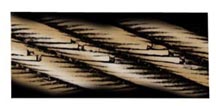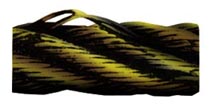Mechanical damage
This is due to rope movement over sharp edge projection while under load.

Localized wear
This is due to abrasion on supporting structure. Vibration of rope between drumand job head sheave.

Narrow Path of Wear
This results in fatigue fractures, caused by working in a grossly oversize groove or over small support rollers.

Parallel Broken Wires
Two parallel paths of broken wires are indicative of bending through an undersize groove in the sheave.

Severe Wear
This is associated with high tread pressure. Protrusion of fibre main core.

Severe Wear in Lang Lay
This is caused by abrasion of cross-over points on multi-layer coiling application.

Corrosion of severe degree
This is caused by immersion of rope in chemically treated water.

Typical Wire Fractures
This is a result of bend fatigue.

Wire Fractures at the Strand
Fractures at the strand, or core interface, as direct from ‘crown’ fractures, are caused by failure of core support.

Break of IWRC
This is a result from high stress application. Note nicking of wires in outer strands.

Strand Core Protrusion
This happens as a result of torsional unbalance created by ‘drop ball’ application (i.e. shock loading).

Localized Wear and Deformation
Typical example of localized wear and deformation created at a previously kinked portion of rope. The danger here is that it’s invisible during the rope’s operation, and that’s why you need to inspect this portion of an operating rope regularly. The rope should be pulled off the sheave during inspection and bent to check for broken wires.

Bird-Caged
Multi-strand rope ‘bird-caged’ due to torsional unbalance or the sudden release of tension and the resulting rebound of rope. These strands and wires will not be returned to their original positions. Typical of build-up seen at anchorage end of multi-fall crane application.

Protrusion of IWRC
This is resulting from shock loading.

Some information on this page was taken from AWRF (American Wire Rope Fabricators)
